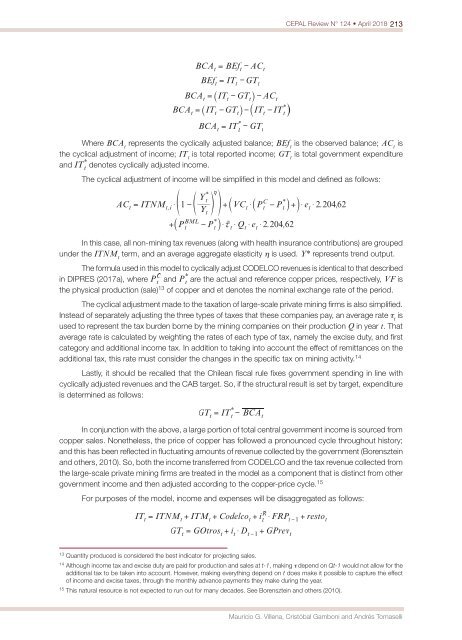CEPAL Review no. 124
April 2018
April 2018
You also want an ePaper? Increase the reach of your titles
YUMPU automatically turns print PDFs into web optimized ePapers that Google loves.
<strong>CEPAL</strong> <strong>Review</strong> N° <strong>124</strong> • April 2018 213<br />
BCA BEf AC<br />
t t t<br />
BEf IT GT<br />
t t t<br />
Where BCA t<br />
represents the cyclically adjusted balance; BEf t<br />
is the observed balance; AC t<br />
is<br />
the cyclical adjustment of income; IT t<br />
is total reported income; GT t<br />
is total government expenditure<br />
and de<strong>no</strong>tes cyclically adjusted income.<br />
The cyclical adjustment of income will be simplified in this model and defined as follows:<br />
In this case, all <strong>no</strong>n-mining tax revenues (along with health insurance contributions) are grouped<br />
under the ITNM t<br />
term, and an average aggregate elasticity η is used. Y* represents trend output.<br />
The formula used in this model to cyclically adjust CODELCO revenues is identical to that described<br />
in DIPRES (2017a), where and are the actual and reference copper prices, respectively, VF is<br />
the physical production (sale) 13 of copper and et de<strong>no</strong>tes the <strong>no</strong>minal exchange rate of the period.<br />
The cyclical adjustment made to the taxation of large-scale private mining firms is also simplified.<br />
Instead of separately adjusting the three types of taxes that these companies pay, an average rate τ t<br />
is<br />
used to represent the tax burden borne by the mining companies on their production Q in year t. That<br />
average rate is calculated by weighting the rates of each type of tax, namely the excise duty, and first<br />
category and additional income tax. In addition to taking into account the effect of remittances on the<br />
additional tax, this rate must consider the changes in the specific tax on mining activity. 14<br />
Lastly, it should be recalled that the Chilean fiscal rule fixes government spending in line with<br />
cyclically adjusted revenues and the CAB target. So, if the structural result is set by target, expenditure<br />
is determined as follows:<br />
In conjunction with the above, a large portion of total central government income is sourced from<br />
copper sales. Nonetheless, the price of copper has followed a pro<strong>no</strong>unced cycle throughout history;<br />
and this has been reflected in fluctuating amounts of revenue collected by the government (Borensztein<br />
and others, 2010). So, both the income transferred from CODELCO and the tax revenue collected from<br />
the large-scale private mining firms are treated in the model as a component that is distinct from other<br />
government income and then adjusted according to the copper-price cycle. 15<br />
For purposes of the model, income and expenses will be disaggregated as follows:<br />
13<br />
Quantity produced is considered the best indicator for projecting sales.<br />
14<br />
Although income tax and excise duty are paid for production and sales at t-1, making τ depend on Qt-1 would <strong>no</strong>t allow for the<br />
additional tax to be taken into account. However, making everything depend on t does make it possible to capture the effect<br />
of income and excise taxes, through the monthly advance payments they make during the year.<br />
15<br />
This natural resource is <strong>no</strong>t expected to run out for many decades. See Borensztein and others (2010).<br />
Mauricio G. Villena, Cristóbal Gamboni and Andrés Tomaselli


















